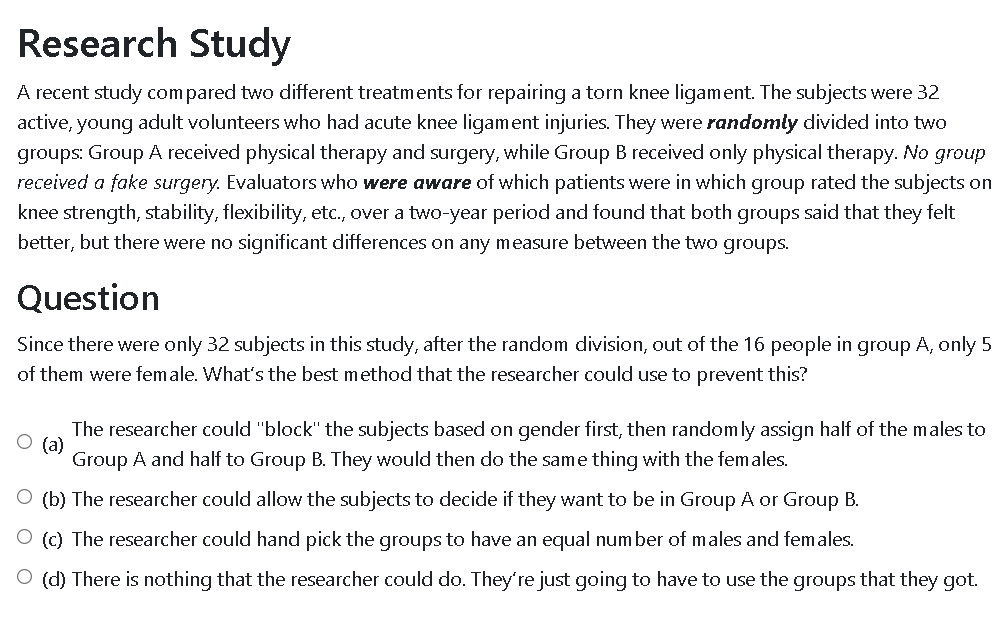A recent study compared two different treatments for repairing a torn knee ligament. The subjects were 32 active, young adult volunteers who had acute knee ligament injuries. They were randomly divided into two groups: Group A received physical therapy and surgery, while Group B received only physical therapy. No group received a fake surgery. Evaluators who were aware of which patients were in which group rated the subjects on knee strength, stability, flexibility, etc., over a two-year period and found that both groups said that they felt better, but there were no significant differences on any measure between the two groups.
A recent study compared two different treatments for repairing a torn knee ligament. The subjects were 32 active, young adult volunteers who had acute knee ligament injuries. They were randomly divided into two groups: Group A received physical therapy and surgery, while Group B received only physical therapy. No group received a fake surgery. Evaluators who were aware of which patients were in which group rated the subjects on knee strength, stability, flexibility, etc., over a two-year period and found that both groups said that they felt better, but there were no significant differences on any measure between the two groups.
Glencoe Algebra 1, Student Edition, 9780079039897, 0079039898, 2018
18th Edition
ISBN:9780079039897
Author:Carter
Publisher:Carter
Chapter10: Statistics
Section10.6: Summarizing Categorical Data
Problem 28PPS
Related questions
Question
4

Transcribed Image Text:Research Study
A recent study compared two different treatments for repairing a torn knee ligament. The subjects were 32
active, young adult volunteers who had acute knee ligament injuries. They were randomly divided into two
groups: Group A received physical therapy and surgery, while Group B received only physical therapy. No group
received a fake surgery. Evaluators who were aware of which patients were in which group rated the subjects on
knee strength, stability, flexibility, etc., over a two-year period and found that both groups said that they felt
better, but there were no significant differences on any measure between the two groups.
Question
Since there were only 32 subjects in this study, after the random division, out of the 16 people in group A, only 5
of them were female. What's the best method that the researcher could use to prevent this?
The researcher could "block" the subjects based on gender first, then randomly assign half of the males to
(a)
Group A and half to Group B. They would then do the same thing with the females.
O (b) The researcher could allow the subjects to decide if they want to be in Group A or Group B.
O (c) The researcher could hand pick the groups to have an equal number of males and females.
(d) There is nothing that the researcher could do. They're just going to have to use the groups that they got.
Expert Solution
This question has been solved!
Explore an expertly crafted, step-by-step solution for a thorough understanding of key concepts.
This is a popular solution!
Trending now
This is a popular solution!
Step by step
Solved in 2 steps

Recommended textbooks for you

Glencoe Algebra 1, Student Edition, 9780079039897…
Algebra
ISBN:
9780079039897
Author:
Carter
Publisher:
McGraw Hill

Holt Mcdougal Larson Pre-algebra: Student Edition…
Algebra
ISBN:
9780547587776
Author:
HOLT MCDOUGAL
Publisher:
HOLT MCDOUGAL

Glencoe Algebra 1, Student Edition, 9780079039897…
Algebra
ISBN:
9780079039897
Author:
Carter
Publisher:
McGraw Hill

Holt Mcdougal Larson Pre-algebra: Student Edition…
Algebra
ISBN:
9780547587776
Author:
HOLT MCDOUGAL
Publisher:
HOLT MCDOUGAL